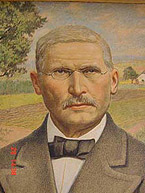Schrift: größer/kleiner
Inhaltsverzeichnis
Sie sind hier: WirRheinländer > english version > Industrialisation > The Agricultural Revolution
Industrialisation / Proletariat
The Agricultural Revolution
Although much slower than the industrial revolution, radical change also came about in agriculture. Around 1850 there were labour-saving machines available for almost every activity, although problems with steam technology and lack of money dissuaded many farmers from buying them. Numerous farmsteads, fewer on the Rhine than beyond the Elbe, were burdened by payments related to the liberation of the peasants. Increases in agricultural prices, yields per hectare and livestock from 1826 to 1875 hardly had any effect on Rhenish small and medium farmers. Their smallholdings, smaller than else-where in Prussia, could not be run more efficiently. There was often no other way out than to move away to the factories.
The agricultural revolution at the Rhine came about less as a radical change in existing laws and property conditions, but rather it caused farming to become professional, with technology, science, tuition and organization.
In 1832 the "Association of endeavours for the public benefit in support of agriculture, commercial activity, intelligence and morality in the Eifel regions" was founded to propagate rational working methods. This was followed in 1834 by the "Oberbergisch Agricultural and Industrial Association" and in 1840 by the "Agricultural Association for Rhine-Prussia", which was established by the authorities to promote the mechanization of work in the fields. In institutes, laboratories and agricultural schools experiments were carried out with new methods of fertilizing the soil, breeding livestock and producing plants - after 1850 the growing of sugar beet increased and this crop became a further element in the Rhenish food industry – as did new forage plants which contributed to the increased productivity of cattle. On the other hand, selective breeding began very slowly. The earliest attempts were concentrated on horses, which were the most important natural power-source.

Since 1839 a regional stud farm in Wickrath had existed for this purpose. In milk production quality control was increasingly carried out by the dairy cooperatives, the first of which had not come into existence until 1866 in Bitburg.
The Agricultural Institute in Poppelsdorf, affiliated to the University of Bonn in 1819, proved to be of outstanding significance, not only for the Rhenish agrarian economy. This Royal Establishment for Education and Practice was provided with a test estate and its status was elevated to "Agricultural Academy" in 1860. In the following decades it achieved outstanding results in the organisation of higher education in agriculture and the testing of new agricultural methods. The dissemination of new procedures and knowledge was also served by the Wandering Teachers' Movement, which began in Malmedy in 1861 and led to the foundation of "Winter Schools", e.g. in Gummersbach in 1875. Another important innovation was the cooperative movement, which started in 1864 and was the brainchild of Friedrich Wilhelm Raiffeisen (1818-1888), born in Hamm on the River Sieg. His principle of cooperative self-help, and the solidarity of joint liability for all members, provided access to affordable loans for countless poor farmers, so that they could buy seeds and machines, and helped them increase earnings on their crops through joint marketing. Raiffeisen's work was the single most important accelerating factor in the agricultural revolution.


